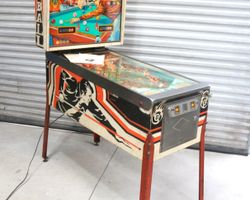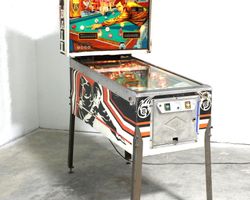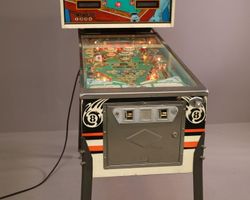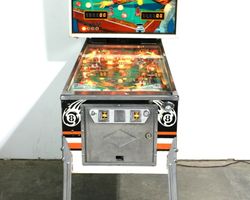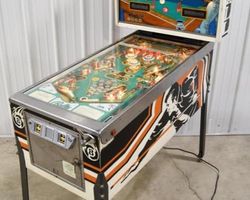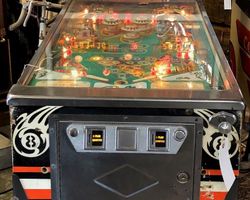Eight Ball
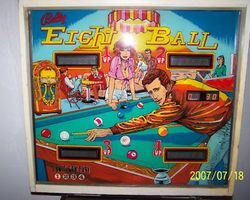
Average Prices: USD $200 to $1,700
Produced: September, 1977
Production Run: 20,230 units
Machine Type: Solid State Electronic
MPU: Bally MPU AS-2518-17
Players: 4
Design by: George Christian
Art by: Paul Faris
The "Eight Ball" pinball machine, released by Bally Manufacturing Corporation in September 1977, arrived during a pivotal period for the industry, as solid-state electronics began to supplant electro-mechanical designs. With a production run of 20,230 units, model number 1118-E, "Eight Ball" quickly became a cornerstone of Bally's early solid-state catalog and a commercial success. The machine’s design was led by George Christian, with artistic contributions from Margaret Hudson and Paul Faris. Its theme, centered around pool and billiards, resonated with a broad audience, drawing players in with familiar imagery and gameplay concepts. A notable element on the backglass features a character reminiscent of a popular television personality of the era, further cementing its connection to the cultural landscape of the late 1970s. Margaret Hudson even included her initials discreetly within the bracelet worn by the girl depicted on the backglass, a detail often missed by casual observers. Early production models of "Eight Ball" featured a unique hinged backglass frame, a design element that distinguishes them from later production runs where the backglass lifted out of the game.
Signature Features and Design
"Eight Ball" distinguished itself not only through its theme but also its distinctive blend of emerging technology and classic pinball charm. Despite being a solid-state machine, its sound was generated by a 4-note MPU-controlled chimebox rather than a dedicated sound board. This offered players the responsive scoring and logic of a modern solid-state system while retaining the nostalgic auditory experience of an electro-mechanical machine, a deliberate choice that contributed significantly to its appeal. The artwork, a collaboration between Margaret Hudson and Paul Faris, embraced the pool hall theme. The cabinet art, depicting a vibrant billiards scene, drew players in, while the playfield and backglass continued the visual narrative. Subtle artistic touches are present, such as two specific light shields on the playfield plastics featuring a second screening of red on top of the normal screening. This creates a unique effect, where colors like a character's shirt can appear red when illuminated and tan when the lights are off, adding a depth to the visual design that is not immediately apparent. The digital display, standard for solid-state machines of its time, clearly showcased scores, which could reach up to 999,990 points per player.
Playfield and Mechanics
The "Eight Ball" playfield is laid out with a focus on clear shots and progressive objectives, inviting players to master its various features. At the core of the lower playfield are two flippers, positioned to control the ball through a network of targets and lanes. Three pop bumpers, located in the upper playfield, provide chaotic yet scoring opportunities, deflecting the ball unpredictably. Two slingshots guard the outlanes, adding to the defensive elements of play. The playfield includes four standup targets, which contribute to scoring and advancing game objectives. A central spinning target offers a high-value shot and adds dynamic movement to the gameplay.
A key defensive feature is the left outlane kickback, which, when active, saves the ball from draining, providing a crucial second chance. The "Bank Shot" alley on the right side of the playfield serves as a crucial lane for increasing the bonus multiplier and eventually lighting the extra ball. Perhaps the most iconic visual element on the playfield is the series of seven "bonus balls" depicted in the center of the lower playfield. These are strategically lit, with balls 1-7 designated for Players 1 and 3, and balls 9-15 for Players 2 and 4, creating a clear visual representation of player progress within the pool theme. The overall aesthetic of the playfield, with its vibrant artwork and strategic lighting, enhances the billiards theme, making the player feel immersed in a game of skill and precision.
Gameplay Dynamics
Gameplay on "Eight Ball" is centered around a straightforward yet challenging progression system, emphasizing shot accuracy and ball control. The primary objective involves a direct interpretation of its pool theme: players must light either all the solid-colored balls or all the striped-colored balls on the playfield. Successfully lighting one set then enables the player to light the central 8-ball. Once the 8-ball is lit and hit, it activates a "Special," typically rewarding the player with a free game or significant points.
Beyond this main objective, several mechanics contribute to the game's depth. The spinning target is a high-reward shot, encouraging players to aim for it repeatedly. The "Bank Shot" alley is integral to accumulating points and extending game time; hitting it multiple times increases the bonus multiplier, essential for achieving high scores, and eventually lights the extra ball. The left outlane kickback, while a beneficial feature, also highlights the challenging nature of the playfield’s design, often requiring precise nudging to avoid premature drains. "Eight Ball" was also noteworthy for its time for incorporating memory features, which allowed for player progress to be retained during multi-player games, a significant advancement over earlier machines. This focus on individual player progression, combined with the clear visual feedback of the lit "bonus balls," encouraged extended play and competition. The machine's design fosters a highly skill-based experience, where high scores are earned through consistent ball control and strategic shot execution rather than random luck.
Reception and Legacy
"Eight Ball" quickly garnered a strong reception, becoming one of Bally’s most successful pinball machines of its era. Its blend of accessible rules and demanding gameplay appealed to a wide demographic, from casual players to seasoned enthusiasts. Many in the pinball community found its straightforward approach to gameplay to be a refreshing contrast to machines with more complex rulesets, praising its addictive, fast-paced nature. The chime sounds, a deliberate choice over early electronic tones, were often lauded for providing a classic, nostalgic feel that resonated with players familiar with electro-mechanical games. The artwork, particularly the cabinet design and the backglass’s character, captured the essence of the late 1970s and contributed to its broad appeal. The game’s focus on skill and ball control, with high scores achieved through precision rather than mere luck, was widely appreciated, positioning it as a rewarding challenge. Its value and accessibility also made it a popular choice for home collectors and operators alike.
However, "Eight Ball" was not without its criticisms. A frequently cited characteristic, and often a point of frustration, is the game's brutal playfield design, particularly the unforgiving left outlane, which earned it the moniker "drain monster." This steep angle and challenging outlane often led to frustratingly short games for unprepared players, necessitating advanced nudging skills to keep the ball in play. While some appreciated the directness of the art, others found it simplistic or dated compared to later designs. Some players also found the chime sounds, while nostalgic, to be somewhat "tinny" or lacking the depth of more sophisticated sound packages that would emerge. A few reviewers also noted a perceived monotony in the gameplay, citing a lack of diverse toys or gimmicks compared to other titles. Despite these critiques, the overall sentiment toward "Eight Ball" remained overwhelmingly positive. It’s frequently cited as a classic that evokes strong feelings, proving its enduring appeal. Its significance lies not only in its commercial success as one of the highest-produced solid-state games of its time but also in its contribution to solidifying skill-based gameplay in the transition from electro-mechanical to solid-state machines. "Eight Ball" established a blueprint for engaging, accessible pinball that continues to be a benchmark for pure gameplay enjoyment.
Sponsored Links
 Ebay Listings
Ebay Listings
 Auction Results
Auction Results
| Cost | Location | Date |
|---|---|---|
| USD $2,850 |  Florida, United States Florida, United States |
02 July, 2025 |
| USD $710 |  Tennessee, United States Tennessee, United States |
17 April, 2025 |
| USD $3,889 |  Florida, United States Florida, United States |
16 April, 2025 |
| USD $1,500 |  Georgia, United States Georgia, United States |
22 February, 2025 |
| USD $2,000 |  District of Columbia, United States District of Columbia, United States |
15 February, 2025 |
| USD $4,500 |  Georgia, United States Georgia, United States |
08 February, 2025 |
| USD $9,000 |  California, United States California, United States |
23 January, 2025 |
| USD $725 |  Ohio, United States Ohio, United States |
04 December, 2024 |
| USD $1,400 |  Illinois, United States Illinois, United States |
15 November, 2024 |
| USD $4,995 |  California, United States California, United States |
19 October, 2024 |


Private Policy · Search Website · Contact Us
As an eBay Partner, we may earn a commission from qualifying purchases made through links on this site, at no additional cost to you.
All trademarks and copyrighted materials remain property of their respective owners. All other content copyright 2007 - 2025 Pinpedia.

